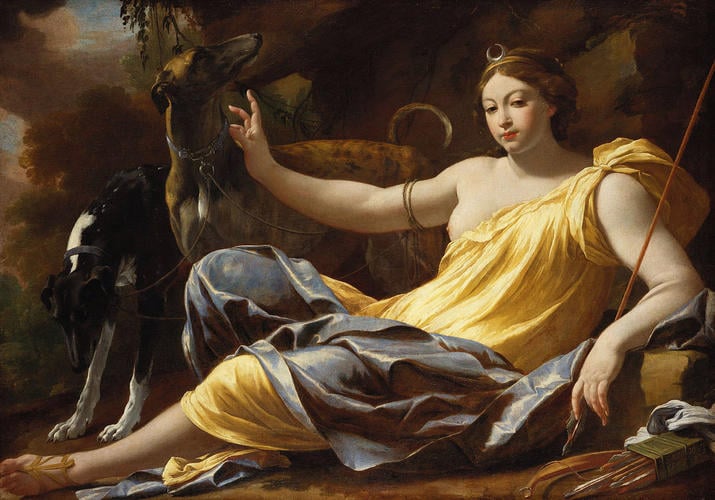Diana Signed and dated 1637
Oil on canvas | 104.3 x 147.5 cm (support, canvas/panel/stretcher external) | RCIN 403930

Simon Vouet (1590-1649)
Diana Signed and dated 1637
-
Simon Vouet was one of the most influential painters working in France in the first half of the seventeenth century. He spent his formative years (1612-1627) in Italy where he absorbed Caravaggio’s naturalism and strong shadows, before turning towards a more decorative and dramatic style, in part inspired by Giovanni Lanfranco. In 1627 he was summoned back to Paris by Louis XIII who made him Premier Peintre du Roi. For the last two decades of his life he executed decorative schemes in country and town houses in and around Paris; sadly few have survived.
It is not surprising that Vouet came to the attention of Louis XIII’s sister, Henrietta Maria, and her husband, Charles I. André Félibien claimed that Vouet sent paintings to Charles I, who sought to bring the painter to England. A Dorigny print records an oval ceiling painting by Vouet (now lost) which once hung at Oatland’s Palace, one of the Queen’s residences. It is certainly worth considering the suggestion that this painting was commissioned by Charles I or Henrietta Maria. It is inscribed by the artist ‘Simon Vouet / F. [fecit] Paris 1637’; the addition of the place of execution is unusual for Vouet and may indicate that the work was to be sent abroad. A print after this composition, also by Dorigny (BM 1841, 1211.39.110), reveals that it was originally oval; what we see now is the largest rectangle which might be cut from it. In its original form it would appear to have been the sort of decorative panel, probably for a ceiling, which the English Royal family were commissioning from Vouet. Anything executed by a Peintre du Roi would require the permission of the French King and might have been intended as a gift. In this case the subject would be most appropriate, as Diana is so prominent in the Renaissance decoration of the royal palace of Fontainebleau. Unfortunately there is no record of this work in the inventories of Charles I or in the Commonwealth Sale; it surfaces in 1710, described as a ‘Diana of Vouet’, over the door in the Drawing Room of Somerset House – traditionally the Queen’s residence. Overdoors are usually rectangular so we must assume that the reduction had already happened by this date. It is not impossible that the work escaped notice as part of a decorative scheme or followed Henrietta Maria into exile, returned to England and found its way to Somerset House without attracting attention. It is first listed with measurements (matching its present dimensions) in 1818 in Queen Caroline’s Dressing Room at Kensington Palace, attributed to Hondius.
In this rare single figure composition Vouet explores the idea that Diana exhibits a wild and ‘natural’ kind of beauty, as opposed to the artifice of Venus. The original oval shows more of the rough rocky terrain in which the huntress has strayed and risks become benighted. Her only ornament is provided by her dogs’ leads wrapped around her upper arm exactly where Venus wears a gold bracelet (for example in the ‘Crouching Venus’ in Charles I collection, RCIN 69746, on loan to the British Museum). Her posture makes a crescent shape and she reflects a cool, silvery light as if imitating the properties of her attribute, the moon.Provenance
First recorded in the Royal Collection in 1710 at Somerset House
-
Creator(s)
-
Medium and techniques
Oil on canvas
Measurements
104.3 x 147.5 cm (support, canvas/panel/stretcher external)
117.4 x 159.8 x 8.2 cm (frame, external)
Category
Object type(s)








